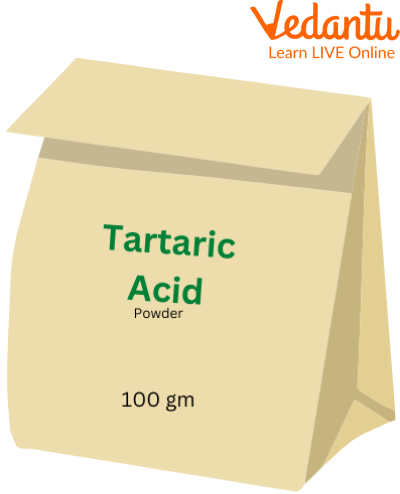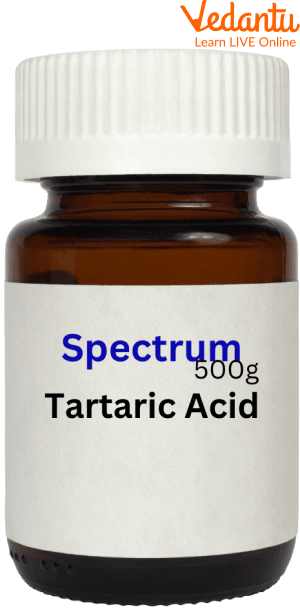




Overview of Tartaric Acid
Kids, do you know which acid is found in your favourite tamarind sauce? Yes, it’s tartaric acid. Tartaric acid is an organic acid found in various fruits, plants, and wine. People use tartaric acid in various ways in different industries. Tartaric is used commercially as a flavouring and an additive agent in food industries. Due to its unexceptional uses, it is also used in many industries like photography, pharmaceuticals, tanning, ceramics, and textile printing.
We will discuss the uses of tartaric acid in detail in this article. So let’s move further and read the article!

A Packet of Tartaric Acid
What is Tartaric Acid?
Tartaric acid is a crystalline white solid acid that occurs naturally. It is an organic acid and is found in many fruits, such as citrus fruits, tamarind, bananas, and, most notably, grapes. Tartaric acid is also used as a food additive in baking powder. The chemical name of tartaric acid is dihydroxybutanedioic acid. It is one of the most common and widely distributed plant acids and is a dicarboxylic acid.
The history of tartaric acid goes back to 1769 when it was isolated by Carl Wilhelm Scheele, a Swedish chemist, for the first time. Tartaric acid was already in observation by the Romans and Greeks. They observed 'tartar' as a partially purified form of acid. Tartaric acid is obtained as a by-product of wine fermentation.
Tartaric acid is a crystalline solid with a pungent taste and is highly soluble in water. It is also used in foods for its antioxidant properties and sour taste.

Grapes Contain Tartaric Acid
Important Points About Tartaric Acid
Let's see some important points about tartaric acid:
Chemical Formula: C4H6O6
Chemical Name: Dihydroxybutanedioic acid
Molar Mass: 150 gram per mole
Density: 1.79 grams per millilitre
Melting Point: 171°C
Boiling Point: 275°C
Appearance: Crystalline solid
Solubility: Soluble in water
Uses of Tartaric Acid in Food
Tartaric acid is widely used in the food and preservative industry. Tartaric acid is also a major component of the baking industry as it is used as a leavening agent in baking powder. It also enhances the colour and fruit flavour of the bakery items. The salt form of tartaric acid is called the 'cream of tartar and is a preservative agent.
Pharmaceutical Uses of Tartaric Acid
Medicinal uses of tartaric acid are because it has anti-inflammatory and antioxidant properties, which help in keeping our immune system healthy. Pharmaceutical uses of tartaric acid include the formulation of drugs for heart diseases, effervescent tablets and powders, and antibiotic tablets.
Tartaric Acid Uses for Skin
Along with the food and pharmaceutical industry; tartaric acid is also of great help in the cosmetic industry. Many cosmetic products like creams, moisturisers, and serums have tartaric acid in their preparation. It is an anti-ageing acid that helps maintain the skin's pH level. Tartaric acid is used in the beauty industry as a skin-lightening agent.

Medicine Containing Tartaric Acid
Summary
In this article, we learned that tartaric acid is an organic acid found in various plant products. It is found in fruits we eat, beauty products we use, and even some medicines we take. It is a diprotic acid with two hydrogen atoms on each molecule that can be ionised in water.
We have also discussed many uses of tartaric acids, such as improving the taste of oral medications, acting as a leavening agent and baking soda, as antioxidants, in foods that give a sour taste, inducing vomiting, making silver mirrors and dyeing and textile industry in this article. Due to all these benefits and uses, tartaric acid has become a major component of our lives.
FAQs on Uses of Tartaric Acid
1. Is tartaric acid a strong acid?
Tartaric acid is a strong organic acid widely distributed in nature. It is a stronger acid than other natural acids like malic and citric acid but is a lot weaker than other synthetic acids like hydrochloric acid, nitric acid, or sulphuric acid.
2. What is the main difference between citric acid and tartaric acid?
The difference between tartaric acid and citric acid is that tartaric acid occurs in grapes, bananas, tamarind, and apples, while citric acid occurs mainly in citrus fruits like lemon, oranges, and kiwi. Tartaric acid and citric acid are two different types of plant acid that are used in the food industry as natural additives.
3. What is the purpose of adding tartaric acid to baking soda?
Baking powder is a mixture of tartaric acid and baking soda. The role of tartaric acid in baking is to neutralise a compound called sodium carbonate formed when sodium hydrogen carbonate is heated while cooking. It helps maintain the taste of the food items and prevents them from becoming bitter.
4. What will happen if we take a high amount of tartaric acid in food?
The high intake of tartaric acid can lead to severe digestive problems like nausea, inflammation, gastrointestinal infections, and abdominal pain. Tartaric acid also inhibits the production of malic acid and, if taken in large amounts, can lead to paralysis or even death.









